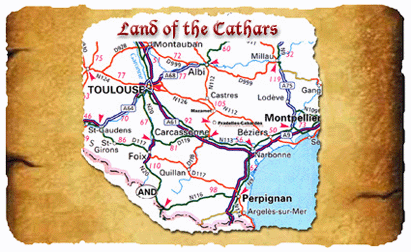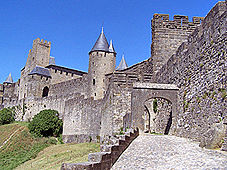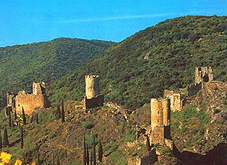
 It has been a huge misunderstanding that the Cathars were anti-Christian. On the contrary, they were good Christians who merely had another view on Christianity than the roman catholic church and its dogmas. They were not dangerous and lived a quiet, peaceful existence. Especially in medicine they had much knowledge. The great Lords of Occitania, some of whom belonged to the Order of the Knights Templar, were fond of them and protected them when the crusade against the Cathars began.
It has been a huge misunderstanding that the Cathars were anti-Christian. On the contrary, they were good Christians who merely had another view on Christianity than the roman catholic church and its dogmas. They were not dangerous and lived a quiet, peaceful existence. Especially in medicine they had much knowledge. The great Lords of Occitania, some of whom belonged to the Order of the Knights Templar, were fond of them and protected them when the crusade against the Cathars began.Many Cathars fled to the fortified cities and castles, but when city after city fell, people fled to Montségur. But even this seemingly impregnable castle was eventually taken in 1244.
 From Montségur, as legends tell us, a small group of Cathars fled and took with them one or more items, which were never found by the crusaders. Even today we can only speculate. Was it the Grail, a green jade bowl, was it the heir of the royal bloodline of Jesus, was it knowledge or was it all of these? We may never find out.
From Montségur, as legends tell us, a small group of Cathars fled and took with them one or more items, which were never found by the crusaders. Even today we can only speculate. Was it the Grail, a green jade bowl, was it the heir of the royal bloodline of Jesus, was it knowledge or was it all of these? We may never find out.This period is also known for its Arthur legends, Grail legends and the songs of the Troubadours. Today, the castles of the Lords are known as Cathar Castles. Some were restored, others are romantic ruins and all of them are worth a visit, but we will only name the most important ones below.
 Chateau d'Aguillar
Chateau d'AguillarFrom Tuchan, 2.5 km in the direction of Narbonne, after the gas station immediately to the right.
At the end of the road a 30 minute walk leads you to the remains of the 12th century castle. Because it was difficult to defend, it was strengthened with a hexagonal wall and six towers. Next to the ruin stands a chapel with a well preserved interior.
 Donjon d'Arques
Donjon d'ArquesThe tower was inhabited as early as the 13th century. Today the building has been restored and is open to the public. In the village of Arques there is a Cathar museum. Also this place is full of mystery. Does the name Arques refer to Bear, Arcas? Or to the Ark?
Carcassonne
This city, which has two separate parts, is an absolute 'must' when you visit the Languedoc.
History
Before the Romans arrived, this particular site was already long inhabited. The Romans built their castellum in the 2nd century B.C. after which the first wall was erected around the fort. After the Romans, the Cité was a Visigoth stronghold. For a very short period it was even taken by the Moors. In this period, the best known legend of Carcassonne came into existence. The story of Madame Carcas, the wife of the Saraceen Balaak.
"When Charlemagne stood before the gates of Carcassonne with his troops, the castle army existed of only one person, Madame Carcas. She gave the illusion that many men were still on the walls. When Charlemagne wanted to starve the castle, and Dame Carcas heard of his plans, she threw a pig over the wall, filled with sweet corn. This made Charlemagne believe that there was still enough food left, so he packed up and left. On the site of his retrieve, she triumphantly blew her horn (Carcas sonne)."
Another story tells of the presence of sun temples or sun churches, which would have been responsible for the name Carcassonne (Karke Sonne). However, it is more likely that its name is based on the name of the Roman fortress, Carcasso. The connection with the sun temples and a possible Egyptian influence in its Celtic history is now a discussion between scholars.
 When Carcassonne was re-conquered from the Moors, it became the possession of several noble families, of which the Trencavel family was the last. In 1074, Lord Bernard Aton Trencavel was the Lord of Carcassonne and the Razés, Agde, Béziers, Albi and Nimes. In the 13th century, the city of Carcassonne had to surrender to the catholic army during the crusade against the Cathars. The 24-year old Count Raymond-Roger de Trencavel was taken prisoner and very badly treated, so that he died only a short time after. This news shocked the Languedoc. Trencavel offered a sanctuary to the Cathars and was therefore taking sides against the church of Rome.
When Carcassonne was re-conquered from the Moors, it became the possession of several noble families, of which the Trencavel family was the last. In 1074, Lord Bernard Aton Trencavel was the Lord of Carcassonne and the Razés, Agde, Béziers, Albi and Nimes. In the 13th century, the city of Carcassonne had to surrender to the catholic army during the crusade against the Cathars. The 24-year old Count Raymond-Roger de Trencavel was taken prisoner and very badly treated, so that he died only a short time after. This news shocked the Languedoc. Trencavel offered a sanctuary to the Cathars and was therefore taking sides against the church of Rome.In 1226, crusade leader Simon de Montfort gave Carcassonne to the French crown, after which a second wall was erected. The son of Raymond-Roger, also called Roger, tried to regain Carcassonne in 1240, but failed and fled to Barcelona. Louis IX, consequently, gave the order to destroy the houses around the castle, after which the inhabitants were driven out of the Cité. They weren't allowed to come back for at least 7 years. In 1248 they received permission to build the Ville Basse (Lower town) on the other side of the river Aude. In the middle of the 14th century, Froissart described Carcassonne as a flourishing town with about 7000 houses and famous for her textile industry. Unfortunately, this industry collapsed around the beginning of the 15th century. It wasn't until the 17th century that the city enjoyed another period of prosperity. In the years of the Revolution, Carcassonne didn't play a large part. However, the economic decay during the Revolution, as well as the Napoleonic Wars and the British Influence around the Mediterranean, ended this period of prosperity. In the late 19th century, Carcassonne renovated its historic buildings and tried to make profit from the wine industry. Today, much of its income and prosperity relies on the tourist industry.
Visiting the Cité
The oldest part is the Cité, the best kept medieval city in Europe. Here you can stroll around its medieval streets. The major attraction is the castle, which you can visit with a guide only. While waiting for the guide, you can take a look at the museum. The guide takes you from the main building over the walls to the other side. You cannot go back to the museum or the attached souvenir shop, so if you want to buy something or visit the museum, you can only do so before the guided tour. At the end of the tour you will see the old St. Nazaire church. This is a Roman/Gothic church with many legends of Templar treasure. Inside you will see among other things an image of the Holy Trinity, a statue of Anna and her daughter Mary, and in the chapel of the Notre Dame (13th century) you can see the Tree of Jesse. The most famous item is no doubt the Siege Stone, on which you can see the Siege of Carcassonne in 1209 by the crusaders.
It is interesting to take a walk in between the walls of the Cité, or do so by tourist train. In July and August there is a feast in the Cité almost every Saturday. Ask the tourist office for more information. The Cité is beautifully lit at night.
 Lastours
LastoursLastours is the name given to four castles: Cabaret (which gave its name to the area called Cabardès), Tour Régine, Fleur d'Espine and Quertinheux. In the 12th century these castles formed the fortification Cabaret. Here, the Lord of the castle, Pierre Roger de Cabaret, fought for and protected the Cathar population of the Montagne Noire. In 1210, Simon de Montfort failed in his first attempt to take Cabaret during the Cathar crusade. The Cathars who had fled the other fortified cities which had already fallen, went to Cabaret, which seemed impregnable. However, in 1211 Pierre Roger de Cabaret was outnumbered by the army of Simon de Montfort and had to surrender. The Cathars who were able to flee, vanished in the woods of the Montagne Noire, where they hid in the many caves. According to legend, the Cathars, who called themselves 'good Christians', were in possession of a treasure, holy relics and secret knowledge, all hidden in several places to avoid destruction by the catholic army.
 Peyrepertuse
Peyrepertuse Accessible from Duilhac by a small road (3,5 km).
This citadel lies on a very high point and visiting the castle is at your own risk. Keep away from the outer walls, especially when it is windy. The climb to the castle can be a heavy one, it is advisable to carry water and keep your head covered from the sun. Don't visit the castle when you are with children.
On the eastside lies the original Peyrepertuse, while St-Georges lies on the westside. This rock has been inhabited at least from Roman times, when it served as a watch and defense post. From Chateau St-Georges, when looking through a hole in the detached watchtower, you have a magnificent view of Queribus.
 Chateau de Puilaurens
Chateau de PuilaurensAbout 9 km east of Axat (from Lapradelle on the D117), on the road from Perpignan to Quillan, via a small road south of the village (D22) and the road which goes up about 800 meters from Puilaurens.
It is a half hour walk to and fro. This enormous military building was the most important fort of the king of France in 1258, to defend the border towards Aragon. In 1636 the castle was taken by the Spanish.
 Puivert
PuivertAccessible from the village of Camp-Ferrier, on the road to Quillan. You drive or walk the 500 meter long, climbing road.
Also this castle was taken by Simon de Montfort in 1210. The castle today is from the 14th century. Only a 32 meter high square donjon and a square tower remain from this period. The visitor is able to visit the donjon. There are 4 rooms, of which the hall of the musicians is most interesting. In the 13th and 14th century, the culture of the troubadours flourished.
 Villerouge-Termenès
Villerouge-Termenès About 10 km north of Mouthoumet on the D613.
The medieval village alone is worth a visit. The beautifully restored castle, which was originally built in the 12th century and fortified in the 14th century, is an absolute must. In 1321, the 'last' Cathar Perfectus was burned at the stake. Inside, an audio-visual show gives insight in the life and times of this Cathar Perfectus Guilhelm Bélibaste, the Archbishop of Narbonne Bernard de Farges and the daily life of the inhabitants of the village. From the castle you can take beautiful photos and video. Every other year, during the Summer months, medieval times live again in Villerouge-Termenès (2002 is such a year).
 Chateau de Termes
Chateau de Termes From the village, partly by car and the rest on foot for about half an hour.
This stronghold, where Cathars hid behind its strong walls in the 13th century, was attacked by Cathar hunter Simon de Montfort in 1210. The gigantic stronghold is only a ruin now, but a ruin with wonderful views over the beautiful serene countryside.
 Quéribus
Quéribus Follow the D123 south of the village. From Le Grau de Maury the road climbs up to the castle.
Please be careful here, especially on a windy day and don't visit the castle with children. In 1255 this ancient stronghold fell into the hands of the crusaders, 11 years after the fall of Montségur! Because the fortress lies on a strategic point, Quéribus was used as a royal garrison. Just like Montségur and Carcassonne, evidence of a sun cult was found. Archaeologists think that the place on which the castle was built, has been used as a military fort or temple for centuries before the Romans, who most likely gave it its name. Unfortunately, time hasn't left much of any of these periods.
 Montségur
Montségur The ruins of the castle are accessible on foot from the parking place, just outside the old town. It's quite a climb, so remember to take water with you and keep your head covered from the sun. It may take up to 90 minutes when you leave from the village and depending on your speed, between 15 and 30 minutes from the parking.
This castle is the most famous of the Cathar castles. It attracts pilgrims from all over the world. On the spot of an earlier fortress, a new castle was built in 1204. Here the soldiers of Pierre-Roger de Mirepoix were stationed, while the Cathars lived in and around the castle. Montségur was one of the last Cathar strongholds to be taken, but that was no easy job. Because it seemed to be the safest place for them, there were many Cathars here, along with their most precious possessions. The siege started in July 1243, followed by many months in terrible Winter conditions. Neither of them gave up. The crusaders then built a catapult on the Roque de la Tour to destroy the buildings which protected the people from the elements.
 On March 2nd, the crusaders agreed to give them a 14-day peace, so that they would get to a decision. Pierre-Roger agreed to surrender, but he wanted the promise that his garrison would be spared. During this period, several Cathars escaped the castle with secret items. This would become the basis of many Grail legends. All other Cathars who would not become roman Catholics, ended in the flames of a huge pyre. The castle you see today is a new building, a third castle, built by the new Lord of Mirepoix, Guy de Lévis II in 1245. On the northwest side of the castle lie the ruins of the Cathar village, where people are excavating the site.
On March 2nd, the crusaders agreed to give them a 14-day peace, so that they would get to a decision. Pierre-Roger agreed to surrender, but he wanted the promise that his garrison would be spared. During this period, several Cathars escaped the castle with secret items. This would become the basis of many Grail legends. All other Cathars who would not become roman Catholics, ended in the flames of a huge pyre. The castle you see today is a new building, a third castle, built by the new Lord of Mirepoix, Guy de Lévis II in 1245. On the northwest side of the castle lie the ruins of the Cathar village, where people are excavating the site.On route to the castle you arrive at the "Prats dels Cramats", where you can see a monument to the Cathars who were burned here on 16th March 1244. The monument, which is situated on one of the loveliest spots in the Midi-Pyrenees, says it all: "Als Catars, als martirs del pur amor chrestian, 16 mars 1244". (To the Cathars, to the marters of the pure christian love, 16th March 1244).
In the village below there are several restaurants and a cafe. There is a lovely shop close to the museum, which is well worth a visit. There are also a beautiful serene camping and several accommodations to choose from.
